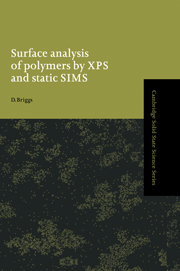Chapter 3 - Information from polymer XPS
Published online by Cambridge University Press: 08 October 2009
Summary
Before discussing the interpretation of polymer spectra it is important to consider two factors which may cause problems. These are sample charging, with the associated problem of binding energy scale referencing, and radiation damage.
Sample charging
Emission of electrons from the surface of an insulator during X-irradiation leads to the creation of a positive surface potential since electrons from the bulk of the sample or from the sample mount cannot compensates for this loss. The effect of this positive charging is a decrease in the kinetic energy of the photoelectrons (i.e. an apparent increase in binding energy). In the case of non-monochromatic X-ray sources a compensating flux of electrons is fortuitously provided by the window of the X-ray source (generally a thin aluminium or beryllium foil) and possibly by impingement of the broad X-ray beam onto other metallic components in the sample vicinity. The overall result is a small equilibrium potential, which is effectively established instantaneously, of typically <10eV (dependent on instrument configuration, take-off angle and X-ray source operating conditions for a given polymer).
In the case of monochromated X-ray sources the situation is much more serious. Firstly, the X-rays are generated remote from the sample. This means that a source of compensating electrons has to be introduced deliberately, generally from a high current, low energy electron source. This is usually referred to as an electron ‘flood’ gun because the beam is designed to cover a large area. Secondly, the X-rays are focused onto a small area and the lack of uniform irradiation can lead to differential charging of the sample. Furthermore, unless the X-ray and electron beams are close to coaxial there will be the additional problem that effective neutralisation may only be possible over a restricted range of take-off angle.
- Type
- Chapter
- Information
- Surface Analysis of Polymers by XPS and Static SIMS , pp. 47 - 87Publisher: Cambridge University PressPrint publication year: 1998
- 11
- Cited by

